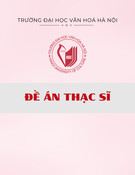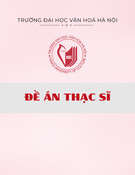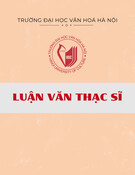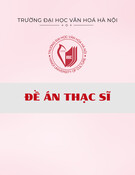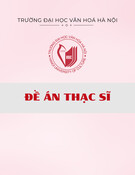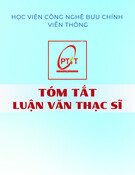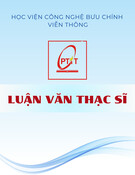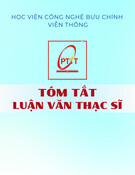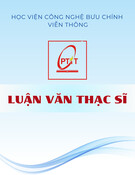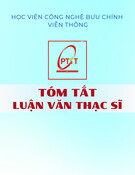
MINISTRY OF EDUCATION
AND TRAINING
VIETNAM ACADEMY
SCIENCE AND TECHNOLOGY
GRADUATE UNIVERSITY OF
SCIENCE AND TECHNOLOGY
-----------------------------
LE HONG THIA
THE STUDY IN ECOLOGY OF THE INDOCHINESE
SILVERED LANGUR (Trachypithecus germaini Milne-Edwards,
1876) AT THE CHUA HANG KARST MOUNTAIN, IN KIEN
LUONG DISTRICT, KIEN GIANG PROVINCE
Area of specialization: Ecology
Code: 9 42 01 20
THE ABSTRACT OF PHD DISSERTATION IN BIOLOGY
Ho Chi Minh City –2019

The dissertation was performed at Graduate University of Science and
Technology, Vietnam Academy Science and Technology.
Supervisor 1: Professor, Dr. Herbert Hadley Covert
Supervisor 2: Dr. Hoang Minh Duc
Reviewer 1:
Reviewer 2:
Reviewer 3:
The dissertation will be defended at the PhD dissertation committee of
Graduate University of Science and Technology, Vietnam Academy
Science and Technology at ………… on………, 20…….
The dissertation was deposited at:
- Library of Graduate University of Science and Technology
- National Library of Vietnam

1
INTRODUCTION
1. Justification of dissertation
The Indochinese silvered langur (Trachypithecus germaini) is one of
twelve colobine species found in Vietnam and its largest population is
found in the Kien Luong Karst area. The silvered langur has a small
distribution range in the Mekong Delta. The previous studies
estimated that the total population size of this species in Vietnam is
between 362 and 406 individuals, and the largest population comprises
286 individuals in Kien Luong Karst Area of Kien Giang Province.
The Indochinese silvered langur is listed as Endangered in the IUCN
2013 - Redlist of Threatened Species as globally endangered A2cd.
Under pressures from habitat destruction through limestone
exploitation in Hon Chong - Kien Luong area by cement companies
and the local community, the local government planned to translocate
the silvered langur population to other karst areas. However,
ecological studies in this species, such as diet and feeding ecology, the
chemistry of their eaten leaves, and the types of locomotions and
substrates they utilized are virtually non-existent. In addition, the lack
of information about the distribution and ecological characteristics for
this species prevent the ability to translocate and develop conservation
strategies. The conservation strategies for the silvered langur in the
Kien Luong area are difficult to perform without field studies, which
will provide a good understanding of ecological such as habitat,
distribution and feeding ecology. Additional information on feeding
ecology and group social structure should be studied to set up a basal
understanding for selecting priority sites in Kien Luong area to support
existing the silvered langur populations and propose immediate
conservation measures.

2
2. The purpose of the study
The main objective of this study was to characterize the ecology of the
Indochinese silvered langur at the Chua Hang Karst Mountain. The
findings from this study add important information needed for the
conservation of the Indochinese silvered langur in Vietnam.
3. The main contents of the study
- Study on the status of the Indochines silvered langur population and
home range size at Chua Hang Karst Mountain.
- Study on phenology and vegetation characterisations at the hibitats
of the Indochinese silvered langur.
- Study on feeding ecology of the Indochinese silvered langur.
- Suggest the solution for conservation the silvered langurs and the
habitats.
4. The highlighs of dissertation
- The dissertation presented the update data on the silvered langur
population size, the group organization, home ranges, and habitat use.
- The dissertation indicated the vegetation characterisation and the
habitats of the silvered langurs at Chua Hang Karst Mountain.
- The dissertation presented new data on activity budget of the silvered
langurs by days, months, year, and seasons.
- The dissertation presented the data of the Indochinese silvered
langur's feeding ecology in the detail, for the fist time.
- By using deep statistical analyze, the dissertation indicated the
relationship between the plant food nutrition and food selection of the
Indochinese silvered langur.
- The dissertation showed the threats for the silvered langur population
which play an important role for the silvered langur conservation.
5. Outline of Dissertation

3
The dissertation consists of 131 pages and devided into 3 chapter with
41 tables and 47 figures.The reference include 228, of which 33 are
Vietnamese references and 195 English references. The dissertation
was devided into chapters and sections as follows: Introduction (5
pages), Chapter 1. Literature overview (22 pages), Chapter 2.
Location, study period and methods (17 pages), Chapter 3. Results and
discussion (84 pages), Conclusions and recommendations (4 pages),
List of articles (1 page), References (14 pages), Appendix 36 pages.
CHAPTER 1. LITERATURE OVERVIEW
1.1. Introduction to the Indochinese silvered langur
The Indochinese silvered langur (Trachypithecus germaini) belong
Old World monkeys (Cercopithecidae family), Colobinae subfamily,
Trachypithecus genus. The general colour of the silvered langur is
silvery grey. Forearms, hands and feet are black. Chin, throat, under
parts of the body, and inner side of arms and legs sparsely covered
with white hairs. Flanks are paler silvery grey than the upper parts.
The tail is above black, beneath silvery grey. The head is grey, the
forehead covered by erect black hairs. The hairs on the head of the
silvered langur form a central occipital crest, and the skin of the face
is completely black. The head and body length is about 550 mm. Their
tails, at 720 to 838 mm, are always longer than their bodies. The
average weight of the silvered langurs is about 6.5 to 7.0 kg.
The Indochinese silvered langur occurs in the South-east Asian
mainland, include south Thailand, Cambodia and South-west
Vietnam. In Vietnam, the silvered langurs were recorded at Kien
Luong Karst Area (ca. 286 individuals), Phu Quoc National Park of
Kien Giang Province (ca. 54 individuals), and small group at Ca Mau
Province. The silvered langurs live in semievergreen, evergreen


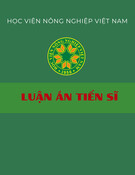
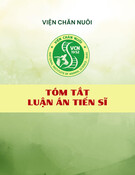
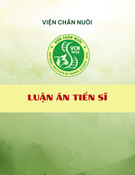









![Đề án Thạc sĩ: Tổ chức hoạt động văn hóa cho sinh viên Trường Cao đẳng Du lịch Hà Nội [Chuẩn nhất]](https://cdn.tailieu.vn/images/document/thumbnail/2025/20251202/kimphuong1001/135x160/91661764646353.jpg)
